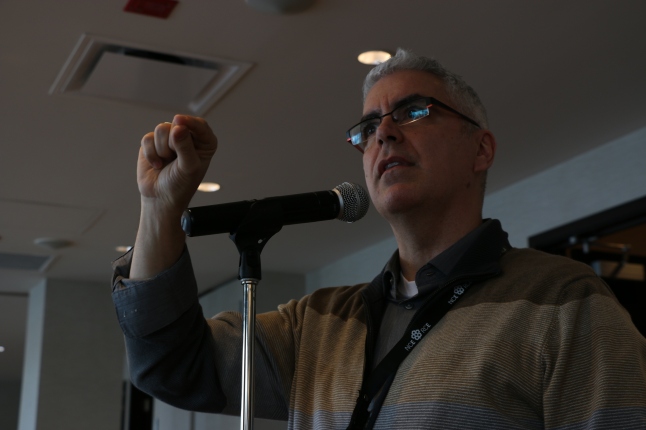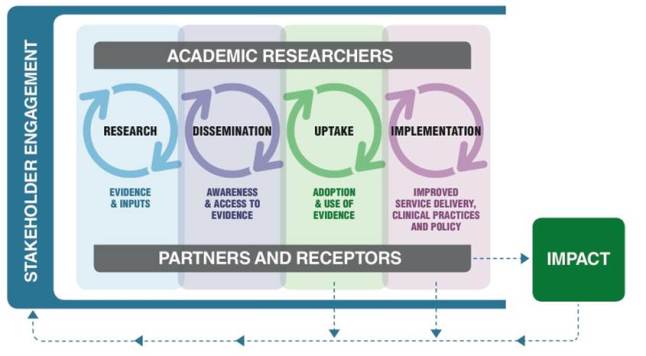Guest post by Stephanie Glegg, PhD Candidate, Vanier Scholar, Public Scholar Rehabilitation Sciences, The University of British Columbia
Wondering if a Lab Exchange will be useful? Worried about the time and expense? Unsure how to optimize your experience?
In this post I share my top 5 reasons a lab exchange can be a good investment.
 I recently received funding from the Kids Brain Health Network (KBHN) for a Lab Exchange with Anneliese Poetz and the KBHN KT Core, based out of York University’s award-winning Knowledge Mobilization (KMb) Unit led by David Phipps. The KBHN is a Canadian National Centres of Excellence focused on improving diagnosis, treatment and support for families raising children with brain-based disabilities. Research teams that engage partners and stakeholders from the community, industry, government, the health care system, the not-for-profit sector and academia drive the network. As an occupational therapist who has worked with these children and families since early in my career, this focus really resonated with me.
I recently received funding from the Kids Brain Health Network (KBHN) for a Lab Exchange with Anneliese Poetz and the KBHN KT Core, based out of York University’s award-winning Knowledge Mobilization (KMb) Unit led by David Phipps. The KBHN is a Canadian National Centres of Excellence focused on improving diagnosis, treatment and support for families raising children with brain-based disabilities. Research teams that engage partners and stakeholders from the community, industry, government, the health care system, the not-for-profit sector and academia drive the network. As an occupational therapist who has worked with these children and families since early in my career, this focus really resonated with me.
The KBHN Knowledge Translation (KT) Core is a support team within the network that helps network members and partners form effective collaborations, and develop effective messaging for different audiences in order to share the findings from their research. My current role with the Evidence Centre at Sunny Hill Health Centre for Children is to help health professionals move evidence into action. As a trainee, my research is focused on studying the best ways to do this. The KT Core seemed like a perfect match to expand my skill set, which started me on the path to creating a lab exchange opportunity for myself.
Here are 5 reasons to take the plunge:
-
You get to tailor your learning experience
A lab exchange is a learning opportunity designed specifically for you. You get to pick the people (your mentors), set the learning objectives and negotiate the learning activities. Reflect on what it is you would like to gain from the experience and from your mentor. Draft some rough learning objectives, and then refine them with your mentor. Collaborate to determine whether the objectives are feasible, what resources and timeline would be required, and the nature of the learning activities that will help you achieve them. As you refine your draft, think about the impact you’d like this experience to have on your career. What knowledge or skills would you like to acquire, and how will you apply them in your future work or career path?
My learning objectives were to be able to:
i. Describe the most frequent KT support needs of KBHN members and the strategies used by the KT Core to address them
My goal here was to determine what skills I might need were I to apply for a similar job, and to reflect on how their services were similar or different to those offered by my resource support team.
ii. Relay guiding principles, effective methods and tips to facilitate stakeholder engagement in KT activities
As I launch into the world of stakeholder-engaged research, learning from both researchers and from those with practical experience facilitating partnerships and engagement would be an asset.
iii. Demonstrate the effective use of various innovative knowledge mobilization methods to target a range of audiences (e.g. generating infographics, podcasts, briefing notes, videos, impact stories, etc.) and to identify effective resources to support their production
As a UBC Public Scholars Fellow, one of my goals is to incorporate non-traditional scholarly work into my PhD dissertation. I plan to generate some of these ‘knowledge products’ to share the key messages from my research with the various audiences who will be interested or impacted by my work. Practical tips, resources and examples to guide my efforts are always helpful.
-
Different perspectives can improve your work
I’m not saying your own research lab isn’t amazing – you probably wouldn’t be there if you hadn’t identified some redeeming features for your learning. But a lab exchange gives you the chance to see what other people in your field are doing. You can pick up tricks and tips from their approaches that differ from yours or those of your lab mates. They can expose you to new ways of thinking, and share resources you didn’t know existed. Learning about their expertise, how they came to develop it and what value it has in their work may spark new professional development goals for you.
I was inspired by the diversity of skills my mentor and her colleagues brought to their work. Anneliese Poetz has a strong background in stakeholder engagement, and is constantly developing new and relevant skills drawn from the fields of visual media, business, software applications, qualitative research and knowledge translation. David Phipps is a leader in research impact, and a highly sought speaker on the topic of KMb, with a background in technology transfer. Michael Johnny is a KMb Manager with York University, who shared insights about his role as a knowledge broker engaging with community stakeholders, and about his capacity building activities and research impact evaluation processes. Simon Landry leads the VISTA (Vision: Science to Applications) network’s KT Core, and is also a podcaster. He and I discussed strategies for engaging researchers in knowledge translation, and the ways in which VISTA and KBHN require different approaches. Exchanging ideas with all of them inspired me to explore future educational opportunities in grounded theory, marketing, video editing and software applications to augment my impact as a KT practitioner and researcher.
-
You might be surprised
A mentor’s approach may lead you to reflect on what you have done (or what you plan to do) in your research, and how it might be improved. The techniques, processes, theories or tools they use could vary drastically from what you are used to, and might make you consider how you would go about setting up your own lab or research program. You might also come to better appreciate the way things are done at your home lab, or the reasons they are done that way.
 At my lab exchange, I was working on a learning activity in which I applied one of the KT Core’s KT planning tools to my doctoral research. I was asked to report on how I had engaged stakeholders in my work. I started out thinking the question was not very relevant to me, but through reflection, came to realize the extent to which I had engaged with different stakeholder groups before and during the research process. Because of that reflection, I can be more deliberate in planning for ongoing stakeholder engagement for the KT activities I will be carrying out moving forward.
At my lab exchange, I was working on a learning activity in which I applied one of the KT Core’s KT planning tools to my doctoral research. I was asked to report on how I had engaged stakeholders in my work. I started out thinking the question was not very relevant to me, but through reflection, came to realize the extent to which I had engaged with different stakeholder groups before and during the research process. Because of that reflection, I can be more deliberate in planning for ongoing stakeholder engagement for the KT activities I will be carrying out moving forward.
-
Networking
You may know your lab well, or other researchers in your institution or city. Reaching out to new experts outside of your current professional circles may create opportunities for you down the road. Learning more about a lab may help you narrow down your list of potential postdoc labs, or identify what it is you’re seeking in a future workplace. Or you may make important connections that could lead to research collaborations or even a job. Try to build in time with more than just your mentor. You may even plan an informational interview or a coffee meeting with someone outside your exchange lab while you are in town, to further expand your network.
I scheduled my Lab Exchange to align with a professional development symposium for clinician scientists so that I could save on travel expenses, but increase my opportunity to engage with others in my field or who share my current career path. Both the symposium and the lab exchange resulted in a solid list of people to whom I will reach out – to explore opportunities to learn more, to inquire about career options, to access resources, to connect with others, and to share my research.
-
Travel
Although I stayed within my home country, you can set up a lab exchange almost anywhere in the world. Travel can augment your trip by giving you important non-academic experiences. You may also glean some great learning about differences in the social, institutional, physical or cultural environment between your lab setting and that of the exchange lab that might influence the phenomena you are studying. Research your trip, establish a budget, and include some down-time to explore. Explore funding options to help cover the costs. Don’t forget to consider the impact your travel will have on your academic progress. You may choose to plan your trip during the conference off-season, or well in advance of funding application or academic deadlines.
How will you know where to find your perfect match?
A lab exchange should be about seeking out unique professional development experiences that augment the learning you are getting at home. Do some research – speak with others in your field, scan social media for thought leaders, make note of key authors in the literature whose work intrigues you. Then reach out!
If you are a KBHN trainee and would like to participate in KBHN’s lab exchange program, contact Dr. Doug Swanson, Research and Training Manager for KBHN, dswanson (at) kidsbrainhealth.ca
Follow Stephanie on Twitter: @stephglegg

 This week, a new
This week, a new  Organizations have recognized the power of social media and try to create content that will be shared, and go ‘viral’, with the end result being uptake and implementation of their messages. There is a fine line between ‘gimmicky-ness’ that could reduce credibility and cause people to ignore
Organizations have recognized the power of social media and try to create content that will be shared, and go ‘viral’, with the end result being uptake and implementation of their messages. There is a fine line between ‘gimmicky-ness’ that could reduce credibility and cause people to ignore  it, and something that can go viral while causing effective uptake of evidence-based messages. The
it, and something that can go viral while causing effective uptake of evidence-based messages. The 












